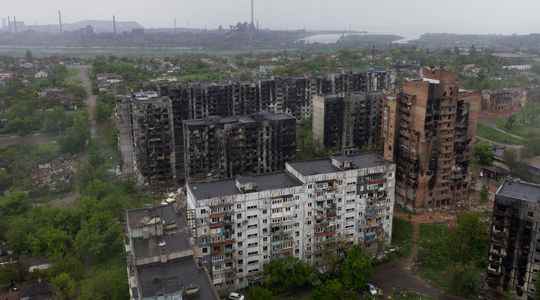Three months after the start of the Russian invasion of Ukraine, Moscow controls 20% of the country, or nearly 125,000 km2, according to Ukrainian President Volodymyr Zelensky. One of the longest and most complicated captures was that of the city of Mariupol, geographically strategic for the Russian army. It fell into the hands of the attackers at the end of May, after having been bombarded and relentlessly attacked by artillery in the service of the Kremlin.
Today, some 150,000 Ukrainian residents remain in the city. And Russia “struggles to provide basic services” to the population of the Ukrainian territories it controls, assured on Twitter, Friday, June 10, the British Ministry of Defense. “Access to drinking water is irregular, while telephone and internet services continue to be severely disrupted,” he said.
The city of Mariupol “is at risk of experiencing a major cholera epidemic” while isolated cases have been reported since May, the ministry adds. “Medical services in Mariupol are probably already on the verge of collapse: a major cholera outbreak in Mariupol will only worsen the situation,” the statement added. Ukraine suffered a major cholera outbreak in 1995.
- Have any cases been confirmed?
If the World Health Organization has alerted to the risk of spreading the disease because of sanitary conditions, it has however notified the newspaper 20 minutes have not received any notification of suspected or confirmed cases in the country.
“No tests have been carried out on the population of Mariupol, so what we believe to be cases of cholera seems to me more like diarrheal diseases, caused by poor access to water”, adds Claire Nicolet, deputy head of the Doctors Without Borders (MSF) emergency unit, interviewed by Release.
- Is the epidemic risk significant?
“Today, the importation of cholera into Ukraine seems highly improbable to me, estimates Professor Renaud Piarroux, head of service at Pitié-Salpêtrière (APHP) and specialist in epidemics, contacted by 20 minutes. For the disease to spread, it has to happen. In a destroyed city where people can neither enter nor leave, I do not see what flow of immigrants would bring cholera. “There is no confirmation that the cholera vibrio has arrived in the country. That does not mean that it cannot happen, but it would have to be imported in one way or another”, abounds Claire Nicolet in the same newspaper.
Nevertheless, in his last note published on May 26the WHO urges caution: “The risk of disease outbreaks, such as cholera, measles, diphtheria or COVID-19, has been exacerbated due to lack of access to water, sanitation and hygiene, overcrowding in shelters in bomb shelters and collective centers, and suboptimal coverage of routine vaccinations”.
“The word ‘cholera’ is being heard more and more in the city among local officials and their supervisors,” said Petro Andryushchenko, the councilor to the city’s mayor, as quoted by The Guardian. The city council also pointed out that the summer heat had “accelerated the decomposition of thousands of corpses under the rubble”. “The city is literally drowning in garbage and sewage,” he added.
- What is the health situation there?
Tuesday, June 7, an adviser to the mayor of Mariupol, Petro Andryushchenko, also warned of a possible cholera epidemic by deploring the deterioration of sanitary conditions in the city. Access to drinking water is also irregular. To access it, residents of Mariupol have to queue for hours, says Petro Andryushchenko on Telegram. And water is only available every other day at most.
This risk is heightened by the state of health facilities across the country, and in particular in Mariupol which has been bombarded relentlessly by the Russian army for almost three months. In early April, while the city was still under fire from bombs, the WHO estimated that more than 100 attacks were perpetrated against health services in Ukraine. The city council of the city says that there is hardly any medicine available in the port city and that the healthcare system is not working. “The city’s hospitals accept up to 50 patients a day, which is nothing for 150,000 people,” he said.
On Monday, Ukraine’s chief medical officer Ihor Kuzin told the New York Times national authorities had started monitoring for possible cholera outbreaks in the country on 1 June. “We cannot be 100% sure that there will be epidemics, he said. But all the preconditions for these are already in place”.
- Cholera, a deadly disease?
Cholera “is an acute diarrheal infection caused by ingestion of food or water contaminated with the bacillus Vibrio cholerae. Cholera remains a global public health threat and an indicator of inequity and insufficient social development,” according to the WHO. It is a virulent disease closely linked to lack of access to drinking water and proper sanitation It is easily transmitted, like gastroenteritis.
While it can be effectively treated with the rapid administration of oral rehydration solution, it can also be fatal if left untreated. “If the patient is not treated in time, he dies in less than 48 hours”, warns Claire Nicolet.
